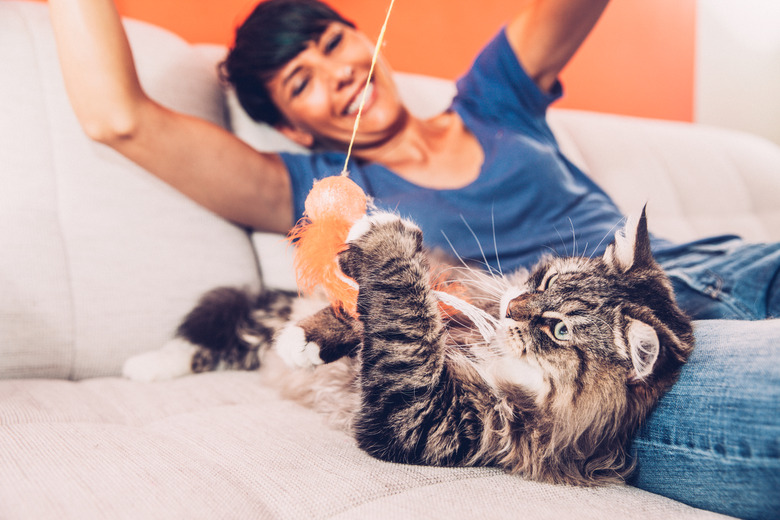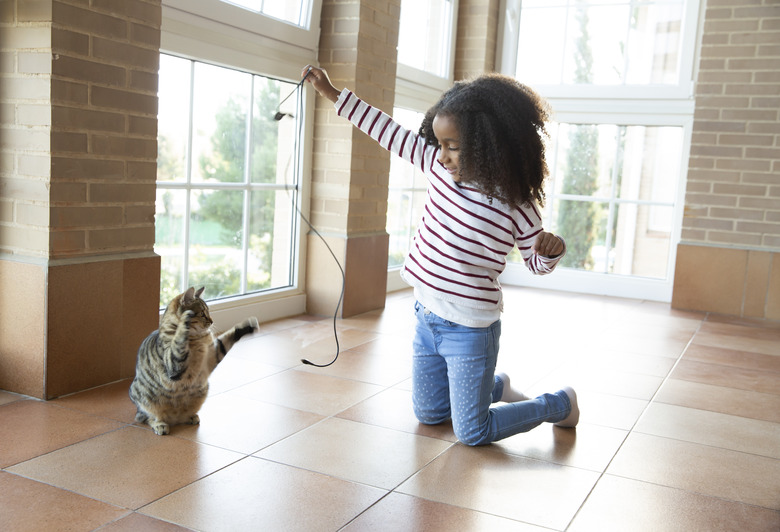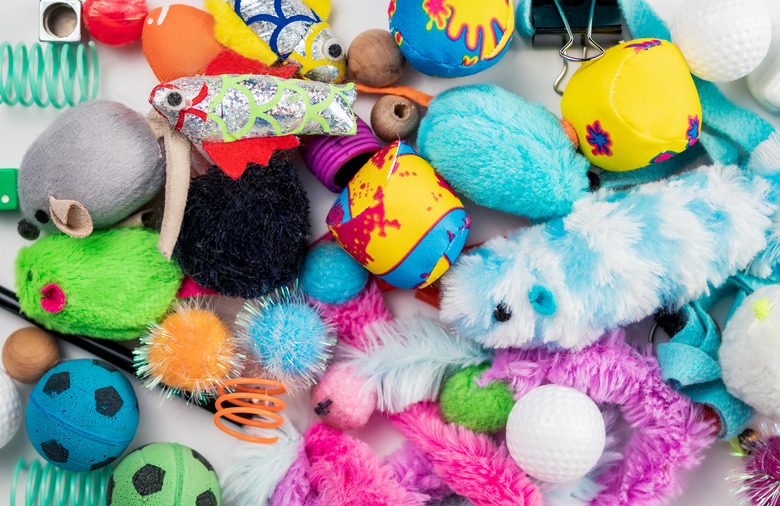Using Games And Training To Bond With Your New Cat
A great way to add enrichment to your cat's day is by playing games together. Many cats can also play on their own. However, boredom and a lack of enrichment can lead to eventual behavior problems in cats. Games are a great way to prevent boredom in cats by channeling their natural instincts to hunt and play. This can also help make your cat happier and more content. Through games and training, you can make sure your cat is getting enough mental stimulation and physical exercise — and also strengthen your relationship.
Find your cat's motivation
Find your cat's motivation
When introducing training and games, you'll need to figure out what your cat finds the most motivating. For most cats, this is an edible treat, but for some cats, toys also work well. Games, where your cat can channel their inner hunting instincts, are good. Experiment with different treats and toys to find out what your cat likes the best. Some cats prefer crunchy treats, which work well for tossing and chasing. Many cats also prefer lickable soft treats or single-ingredient freeze-dried treats. Once you find out what is most motivating, your cat will be very engaged to learn new skills with you.
Build your relationship
Build your relationship
One of the main benefits of engaging with your cat through play, games, and training is that it builds up a reinforcement history of engaging with you. This can help your cat bond more closely with you. Games and training help your cat see you as someone to have fun with. Instead of you only being someone who delivers the food and cuddles, your cat will also see you as someone to play with. Then, they will also seek you out when they are bored or frustrated later on.
New cat
New cat
When you bring home a new cat or kitten, playing games can be an excellent way to jumpstart the bonding process. Playing games can help your new cat feel more secure in their new home, and can help reduce stress and anxiety. Games can also provide you with vital information to help you learn more about your new cat's personality, likes, and dislikes — to help you get a better understanding of them.
Cat treats
Cat treats
With all of the games you play, you'll also want to have a variety of cat treats on hand. The treats should depend on your cat's individual preferences. Soft and lickable treats can be especially useful for teaching cats new tricks. On the other hand, hard and crunchy treats are the easiest to use inside cat puzzles. You can help your cat stay excited and engaged with the games by having a variety of treats for them.
Natural instincts
Natural instincts
Some of the best games for cats are those that channel your cat's natural instincts. Cats are naturally inquisitive and they enjoy games that let them explore, chase, and hunt. Games and activities that channel these natural instincts provide fantastic physical and mental enrichment. These games can increase a cat's confidence, reduce boredom, and improve their overall quality of life.
Types of games
Types of games
There are a variety of games you can play with your cat, and you don't need a lot of supplies or equipment to get started. In fact, there are a wide variety of games you can play using only treats, toys, and supplies — that you probably already have around the house. A few fun games to play with your cat are:
Chase games: Gently toss/slide toys or crunchy treats across the floor and encourage your cat to chase them. After your cat chases the tossed treat, they will then start returning to you. This is your cat's way of asking you to throw the reward again. For cats who enjoy chasing, you can also purchase a wand toy. Wand toys that have feathers or plush toys at the end are a great way to help cats get more exercise and encourage their interest in toys.
Scent games: Cats have a great sense of smell. Hide treats or toys in empty cardboard boxes or paper bags. Then, spread the boxes and bags around the room and let your cat go on a hunt to search and find which boxes/bags have the treats inside them. You can also hide treats under empty yogurt containers or flowerpots.
Fishing game: Cats are curious and enjoy using their front paws to explore. A fun fishing activity for cats is to take a sturdy bowl and put some clean water in it. Next, add some plastic or other waterproof cat toys into the bowl. Show it to your cat and let them experiment with fishing the toys out of the water. This game can get a bit messy, so it's best to play this somewhere with easy-to-dry floors, like a kitchen or bathroom.
Puzzle games: There are a variety of puzzles and interactive toys designed for cats that you can purchase. These puzzles have compartments where crunchy treats or kibble can be added inside. Then, your cat can push the treat ball or manipulate the puzzle to release the treats. You can also create DIY puzzles by taking empty cardboard boxes and cutting holes in them. Then, drop treats or kibble into the box and let your cat use their paws to pull out the treats from the box.
Play foundations
Play foundations
Working with your cat to develop a strong foundation for their play and training will benefit them for the rest of their life. By spending quality playtime, you are also investing in the relationship that you have together. This can be beneficial in stressful situations, from moving to a new home to when you bring your cat to the veterinarian. Using the enrichment games that your cat knows and enjoys can help reduce stress, and help your cat feel secure when there are schedule changes.
Trick training
Trick training
Trick training is also a fun way to spend quality time with your cat. It can encourage your cat to engage with you and also provide them with mental and physical stimulation. Trick training can also be an easy way to structure the play sessions with your cat. Tricks should always be taught using positive reinforcement training methods, and by using treats and/or toys to reward your cat. Use treats that your cat is excited about to lure and encourage behaviors — which you can then add cues onto. One easy trick to first teach your cat is to spin on cue. To start, get your cat's attention with a treat and then lure them into a circle to follow the treat. The better your cat gets, the more you can phase out the need to lure them with the treat. After your cat finishes spinning, give them the treat as a reward.
In summary
In summary
Structured play through training and games are great ways to spend quality time with your cat. Playing games can help your cat to see you as fun and engaging. Games that can channel a cat's natural instinct to chase, hunt, fish, and explore are especially rewarding to them. Playing can be a great way to add enrichment to your cat's day by reducing stress, decreasing boredom, and improving their overall quality of life. Spending quality time playing with your cat will also have a positive impact on your relationship.



